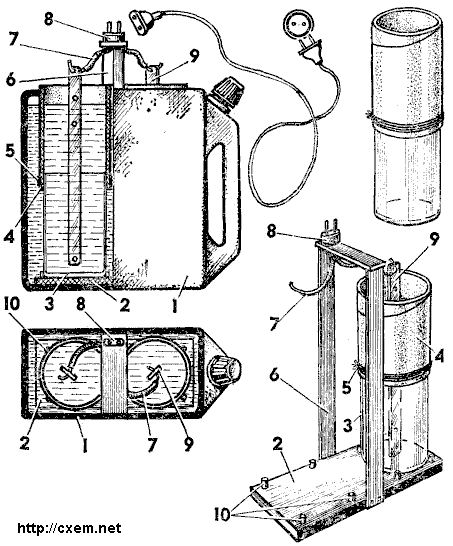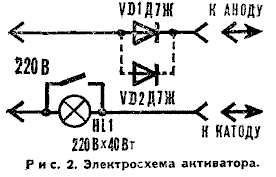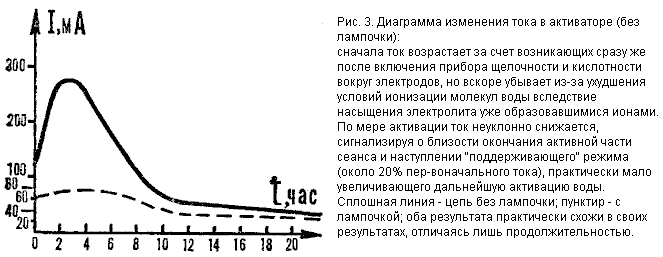It seemed why, there is nothing more familiar than water, and still nothing more mysterious than she is. Remember: from the spring to the ocean - the forms of its existence in liquid state; a trickle of steam from the kettle and clouds in the sky - she's in gaseous; fluffy snow and hard ice - all the same water; and physics still know so called heavy water promising a substantial contribution in energy of the future. Always it was known that freezes water breaks pipes and vessels. And suddenly the mysteries; in the capillaries thinner hair and she in the cold remains liquid. How many more mysteries in it?
In recent years - another mystery and new clashes opinions around unusual properties of the same ordinary water, but already subjected the effects of shock. I.e. the so-called living water. However, this the effect was observed earlier, at the electrolysis, but as a temporary: by passing a current between lowered into the water by the electrodes around one of them (the anode) formed acid Wednesday, and near the other (cathode) - alkaline; but after off current fluid became the same again neutral. Introduction between electrodes dense semipermeable partitions allowed without breaking the effect, to prevent reverse mixing formed under current environments, to obtain two different liquid anolyte and catholyte. Their the study led to the discovery of new active the unusual properties of water: the acolyte they oxidation, catholyte and restoration. The study of their institutions and industry laboratories Tashkent, Kazan, Moscow, Kiev, Leningrad and some other cities showed a wide range of possible practical applications of these properties from production to consumer.
Employees of the food industries, such as interested that acid water is able to increase the timing storage of perishable products, doctors - that she stops inflammatory processes and therefore suitable for scratches and wounds, and wiping them then alkaline water accelerates healing. Gave some interesting results experiments with plants. One group watered with plain water, other - alkaline (catholyte), the third - acid (anolyte). On compared to the first plants the second group developed much faster, and the third wshadow did not exist. But when this third phase then began to pour alkaline water - plants not only sprouted, but quickly overtook the first two groups.
For those who would like to experience properties activated water when the cultivation or "treatment" houseplants, germination of seeds or the harvesting of vegetable seedlings cultures description of the proposed the simplest apparatus, made by the inventor V. Hakulinen, to receive the living water.

Fig. 1. Activator and key details: 1 - canister, 2 - pallet. 3 - Cup, 4 - shell (Whatman),
5 - thread, 6 - pen stand, 7 - wire suspension, 8 - plug connector, 9 - electrodes,
10 - pins-limiters.
Manufacturer homemade electrolytic cells to obtain aktivirovannoi water is mainly following diagram: glass Bank of water, it is omitted also filled with water canvas bag, and in both these tanks entered the electrodes of stainless steel sheet, one of which is included in network directly and the other through diode 5-10 A (for example, type D). The process of revitalization lasts a few minutes (at tightening his water can to boil).
Such devices unsafe and not deprived disadvantages. First and foremost manufacturers such activators forgot the first the Faraday's law, which does not have to strive apply "big amps": well you can do milliamperes, respectively extending the session impact at low currents it is overheating not threatened. Need powerful expensive diode - it replaced by more simple penny value designed for maximum the rectified current of the order of 0.3 And (for example, type DG or with any another letter on the end). For greater reliability can to include in the circuit in parallel two such diode.
Activator with mode of operation in milliamperes much safer: the device can't stay long included, and the water in it, a little poeples at the beginning, we don't heated, because as activation current becomes less than its initial values 2-4 times. The final the results of activation will be completely equivalent the mode with the "big" amps: after all, they are the same, will through the device current in 5 A during the 5 min (300 s) or 0.05 And 500 min (30000 (C):
H=0,H=1500.
Final the number is the number of units electric charge (pendants), passed through the water in both modes of activation.
Device activator at low currents it is clear from the figure. In a small plastic canister with the top cut off there are two usual thin glass walls of which are extended shells from of drawing paper. All three of these tanks filled water glasses descend the electrodes of the device ready to connect. The water in the canister will transfer the environment for current and anolyte and catholyte will get in the cups.
That glasses it was more convenient to take the end of the process, from sheet polystyrene made simple with pallet struts and jumper-handle, on which are mounted forklift connector and wire hooks suspension electrodes (as is customary in electroplating).
Shells for capacity glasses cut from a sheet of drawing paper H mm, pre - boiled to remove from paper technological glue. The resulting blank tight wound up on the edge of the glasses and secured with thread.

In the diagram power activator pictured lamp 220V of 40 watts. Simple the switch allows short-circuiting it when it is desirable to speed up the process. The lamp plays the role the fuse for the diode. In addition, the change the degree of intensity of its threads to judge the stage of activation: the end of the process it burns dimmer.

The shape, size and the interposition electrodes of so much consequence, other case - the selection of the material. Even resistant to corrosion stainless steel in the electrolysis, though in scanty quantities, but soluble in the anolyte, and most of those varieties that are more sensitive to the magnet. So attracted to the magnet material is not suitable: the electrode from it after a short consumption becomes rough, its weight is reduced - there is an active dissolution. Good electrodes are obtained from Cutlery marked "Stainless", and also from skewers (without any change the shape).
Because tap water is always there impurities of chlorine, fluorine, and iron different salts on paper shells spots, and the electrodes (especially the cathode) - matte touch. The last is easy removed with a cotton swab moistened with vinegar; you may also to change the electrodes seats the plaque will disappear. And shells you should occasionally update.
Preparation the device begins to work with fill it (starting with glasses to not pop up) water to the same level, 15-20 mm below the shell edges. Then lowered the glasses and are hung on hooks electrodes, the plug connector attaches the cord, and the device included in the network. On successful during activation will be to testify one interesting symptom: the visible appearance the difference of water levels in all three tanks at the expense of so called osmosis. Acid water (in a glass, the electrode which is connected via a diode) will reduce your level relatively neutral water in the canister, and alkaline, on the contrary, increase it on tighter size (about 3-6 mm).
The degree acidity and alkalinity usually estimated so called hydrogen indicator "pH" measured almost inaccessible in everyday life device "Ionomer". It indications in plain water "pH"=7, the catholyte rises to 10 or more, the anolyte - 2.5 and less.
Home conditions of the fluid can be checked a litmus test. However obsegetunse sample phenolphthalein, which sold in pharmacies (sometimes under the name "Blizzard"). Dissolve the tablet in a tablespoon of water, and in the other scoop catholyte and drip in he phenolphthalein: catholyte immediately turns red (after two-week storage blushes slower). If now painted catholyte to drip in a sample of analyte - occur discoloration that demonstrates sufficient the activity of the anolyte.
In conclusion long-term preservation properties of activated water. According to my observations, the anolyte remains active and the month, and two (perhaps that is stored and longer). Catholyte in week loses not less quarters of its initial fortress and weakens.
Author: V. Jahalin; Publication: www.cxem.net






